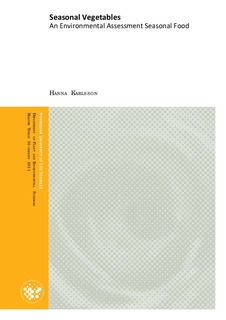Seasonal vegetables; an environmental assessment of seasonal food
Master thesis
Permanent lenke
http://hdl.handle.net/11250/189423Utgivelsesdato
2012-04-20Metadata
Vis full innførselSamlinger
- Master's theses (IPM) [204]
Sammendrag
The environmentally conscious consumer is advised to consume seasonal food even though there is not a universally accepted definition of the term seasonal food. The ambiguity around the term seasonal food concerns the size of the geographical area and the permitted production systems from which the consumer may acquire
seasonal food. This study addresses the ambiguity of the term by focusing on the Swedish per capita consumption
of carrots and tomatoes and by assessing the environmental impact of four different definitions of seasonal food. The four definitions are Swedish season (Habit A), Swedish season without climate controlled greenhouses (Habit B), European season (Habit C) and European season without climate controlled greenhouses (Habit D). Life Cycle Assessment (LCA) was used to assess the environmental impact of tomato and carrot production in Sweden and in
the two main import countries for tomatoes, the Netherlands and Spain, and carrots, the Netherlands and Italy. The impact categories included were global warming potential, fossil fuel depletion, arable land use, acidification potential and eutrophication potential. Habit B with neither climate controlled greenhouses nor long transportation distances had a significantly lower impact for global warming potential, fossil fuel depletion and
acidification potential and the second lowest eutrophication potential but the highest arable land use. The energy use and energy sources for heating in the tomato production were the most important factors for the aggregated impact from tomato and carrot consumption for Habit A and C. Impacts from transportation were significant for
Habit D. Generally, the consumption of carrots contributes 10-30% to the aggregated impact, except for arable
land use where carrot consumption dominates the impact. The study also showed that for produce from climate
controlled greenhouses seasonality is less important for the environmental impact because the impact from energy use and energy source for climate control is significant the whole year around. Meaning that, for tomatoes and probably also other greenhouse grown produce in the Swedish market, consuming seasonal food is inaccurate advice for encouraging environmentally friendly consumption, and instead production methods should be
emphasized more. For open field produced carrots, on the other hand, seasonality is a significant parameter because the environmental impact increases with storage time as energy use and storage losses increase.
